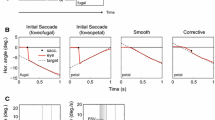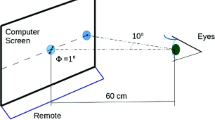Summary
Saccadic latencies measured in response to a step-wise displacement of the target may be substantially reduced if a gap separates the offset of the initial fixation point and the onset of the peripheral target. According to Fischer and Ramsperger (1984) this paradigm provokes a bimodal latency distribution which consists of a peak of very fast saccadic responses (express saccades) at about 110 ms and another peak arising from somewhat slower saccades (regular saccades). Using again the gap paradigm, we investigated the effect of an additional go/no-go (i.e. target trial/catch trial) decision on saccadic latencies. The experiments yielded the following results: (i) the distribution between the peaks of express and regular saccades strongly depends on the proportion of catch trials introduced into the trial sequence, which suggests the existence of different modes of operation of the decision processes for express and regular saccades. (ii) The catch trial effect on saccadic latency proved to be a local phenomenon in time: saccades which follow catch trials tend to be slower than those following target trials.
Similar content being viewed by others
References
Abrams RA, Jonides J (1988) Programming saccadic eye movements. J Exp Psychol [Hum Percept Perform] 14: 428–443
Becker W, Jürgens R (1979) An analysis of the saccadic system by means of double step stimuli. Vision Res 19: 967–983
Boch R, Fischer B, Ramsperger E (1984) Express saccades of the monkey: reaction time versus intensity, size, duration and eccentricity of their targets. Exp Brain Res 55: 223–231
Findlay JM (1981) Spatial and temporal factors in the predictive generation of saccadic eye movements. Vision Res 21: 347–354
Fischer B (1987) The preparation of visually guided saccades. Rev Physiol Biochem Pharmacol 106: 1–35
Fischer B, Boch R (1983) Saccadic eye movements after extremely short reaction times in the rhesus monkey. Brain Res 260: 21–26
Fischer B, Breitmeyer B (1987) Mechanisms of visual attention revealed by saccadic eye movements. Neuropsychologia 25: 73–83
Fischer B, Ramsperger E (1984) Human express saccades: extremely short reaction times of goal directed eye movements. Exp Brain Res 57: 191–195
Fischer B, Ramsperger E (1986) Human express saccades: effects of randomization and daily practice. Exp Brain Res 64: 569–578
Heywood S, Churcher J (1980) Structure of the visual array and saccadic latency: implications for oculomotor control. Q J Exp Psychol 32: 335–341
Kalesnykas RP, Hallett PE (1987) The differentiation of visually guided and anticipatory saccades in gap and overlap paradigms. Exp Brain Res 68: 115–121
Mayfrank L, Mobashery M, Kimmig H, Fischer B (1986) The role of fixation in the occurrence of express saccades in man. Eur Arch Psychiatr Neurol Sci 235: 269–275
Reulen JPH (1984) Latency of visually evoked saccadic eye movements. Biol Cybern 50: 251–262
Ross SM, Ross LE (1981) Saccade latency and warning signals: effects of auditory and visual stimulus onset and offset. Percep Psychophys 29: 429–437
Saslow MG (1967) Effects of components of displacement-step stimuli upon latency for saccadic eye movement. J Opt Soc Am [A] 57: 1024–1029
Schiller PH, Sandell JH, Maunsell JHR (1987) The effect of frontal eye field and superior colliculus lesions on saccadic latencies in the Rhesus monkey. J Neurophysiol 57: 1033–1049
Shephard M, Findlay JM, Hockey RJ (1986) The relationship between eye movements and spatial attention. Q J Exp Psychol[A] 38:475–491
Smit AC, van Gisbergen JAM, Berg RJW (1987) Latency dependence of saccade dynamics in square wave tracking. In: Lüer G, Lass U (eds) Fourth European conference on eye movements. Vol 1. Proceedings. Hogrefe, pp 142–144
Author information
Authors and Affiliations
Rights and permissions
About this article
Cite this article
Jüttner, M., Wolf, W. Occurrence of human express saccades depends on stimulus uncertainty and stimulus sequence. Exp Brain Res 89, 678–681 (1992). https://doi.org/10.1007/BF00229892
Received:
Accepted:
Issue Date:
DOI: https://doi.org/10.1007/BF00229892




